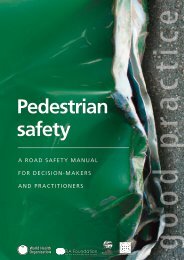What the Pedestrian Wants - International Federation of Pedestrians
What the Pedestrian Wants - International Federation of Pedestrians
What the Pedestrian Wants - International Federation of Pedestrians
Create successful ePaper yourself
Turn your PDF publications into a flip-book with our unique Google optimized e-Paper software.
NovaTerra / jaargang 6 / nummer 1 / april 2006 / 35<br />
Mismatch between 5 km per hour and 60 km per hour signposting.<br />
influences <strong>the</strong> exchange <strong>of</strong> information and<br />
In contrast to this ‘slow’ architecture, <strong>the</strong><br />
a conceptual model for pedestrian movement.<br />
quality <strong>of</strong> communication in urban space,<br />
60 km per hour architecture along <strong>the</strong> roads<br />
Delft University <strong>of</strong> Technology, one <strong>of</strong> <strong>the</strong><br />
and thus its legibility. Stressing this difference<br />
used by vehicles is short on detail and signs<br />
research partners in <strong>the</strong> project, has already<br />
in <strong>the</strong> speed <strong>of</strong> movement, Gemzøe refers<br />
are large and simple to allow easy<br />
conducted field studies in Norwich (October<br />
to <strong>the</strong> research paper he wrote with Gehl<br />
communication <strong>of</strong> information.<br />
2005) and Rouen (December 2005) that focus<br />
at <strong>the</strong> Centre for Public Space Research in<br />
on <strong>the</strong> user’s experience. The ambition is to<br />
Copenhagen: ‘Close Encounters with<br />
According to Gemzøe, some European city<br />
integrate street interviews with electronic<br />
Buildings’. ‘While our perception <strong>of</strong> public<br />
centres originally characterised by ‘slow’<br />
surveillance, such as GPS tests and video<br />
space naturally depends on viewpoint and<br />
architecture have been invaded by cars,<br />
observations, to enable <strong>the</strong> movement<br />
distance, <strong>the</strong> speed at which we move is<br />
leading to a ‘perceptive gap’. Some parts <strong>of</strong><br />
patterns <strong>of</strong> <strong>the</strong> visitor to be documented and<br />
crucial. Rooted in its biological history, <strong>the</strong><br />
<strong>the</strong>se centres present a ra<strong>the</strong>r blank three-<br />
understood more precisely and effectively.<br />
human sensory apparatus is designed to<br />
dimensional surrounding that contains<br />
perceive and process sensory impressions<br />
insufficient detail for a user on foot.<br />
Reactions to: tan@nova-terra.nl<br />
while moving at about 5 km per hour.’<br />
‘This mismatch needs to be overcome if<br />
He went on to describe <strong>the</strong> difference<br />
between 5 km per hour architecture and<br />
60 km per hour architecture. The first<br />
corresponds to our walking pace. On this<br />
scale <strong>the</strong> viewer’s interaction with <strong>the</strong><br />
environment is more intimate: you can smell,<br />
hear and feel all <strong>the</strong> details. Signals and signs<br />
are viewed at a close range and so <strong>the</strong>y can<br />
be small and refined. Walking becomes even<br />
<strong>the</strong> experience <strong>of</strong> <strong>the</strong> pedestrian perceiver<br />
is not to be compromised.’<br />
conceptual model<br />
Copenhagen’s consistent urban design<br />
policies dating from <strong>the</strong> 1960s and <strong>the</strong> works<br />
<strong>of</strong> Pr<strong>of</strong>essor Gemzøe provide a source <strong>of</strong><br />
inspiration for <strong>the</strong> EU Spatial Metro project,<br />
which aims to provide a way <strong>of</strong> making city<br />
References<br />
– Cullen, Gordon. The Concise Townscape. London:<br />
<strong>the</strong> Architectural Press, 1961.<br />
– Gehl, Jan., ‘Close Encounters with Buildings’, Centre<br />
for Public Space Publication, Copenhagen, 2005<br />
(translated from ‘Naerkontakt med huse’ Danish<br />
architectural Magazine: Arkitekten 9/2004).<br />
– Gemzøe, Lars. Public Spaces Public Life. Copenhagen:<br />
The Danish Architectural Press, 1996.<br />
– Lynch, Kevin. The Image <strong>of</strong> <strong>the</strong> City. Cambridge, USA:<br />
MIT Press, 1960.<br />
Z<br />
more appealing if <strong>the</strong> details and displays<br />
centres legible and navigable for visitors and<br />
along <strong>the</strong> way are carefully crafted, and if<br />
local people. Like Gemzøe’s work, this project<br />
<strong>the</strong>re are things to smell and touch so that<br />
tries to understand <strong>the</strong> pedestrian’s<br />
all <strong>the</strong> senses are engaged at some point.<br />
experience <strong>of</strong> historic city centres and adopt






